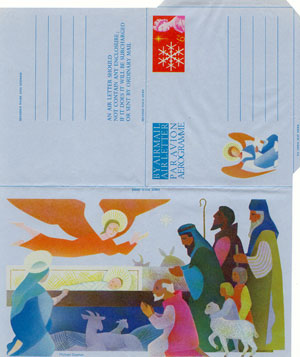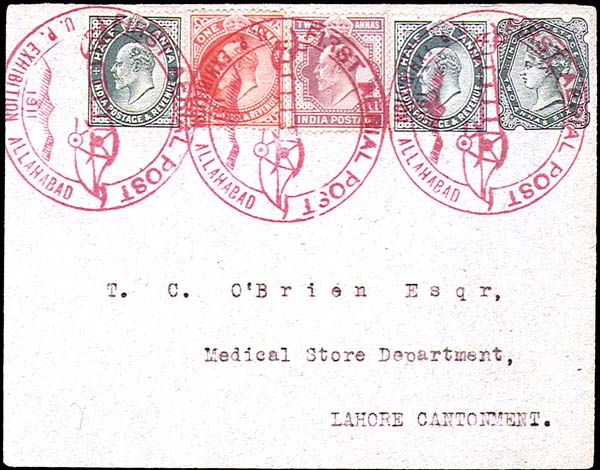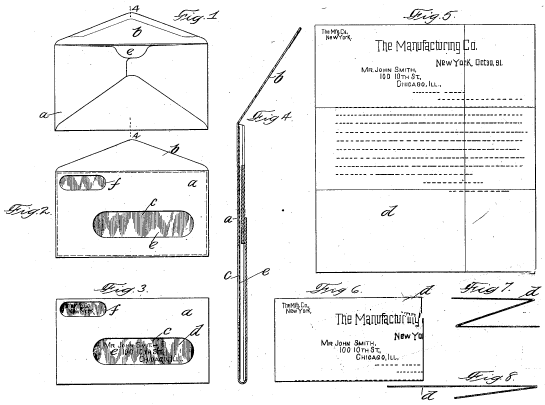|
Aerogram
An aerogram, aerogramme, aérogramme, air letter or airletter is a thin lightweight piece of foldable and gummed paper for writing a letter for transit via airmail, in which the letter and envelope are one and the same. Most postal administrations forbid enclosures in these light letters, which are usually sent abroad at a preferential rate. Printed warnings existed to say that an enclosure would cause the mail to go at the higher letter rate. The use of the term ''aerogramme'' was officially endorsed at the 1952 Universal Postal Union Postal Union Congress in Brussels."The Evolution of the Postal Service in the Era of the UPU" by Jamie Gough in ''The London Philatelist'', Vol.114, No. 1331, December 2005, pp.362-363. Thereafter, the term ''air letter'' quickly faded from use. Most aerograms have an imprinted stamp indicating the prepayment of postage. As such, this meets the definition of being postal stationery. However, some countries such as New Zealand, Zimbabwe and Irel ... [...More Info...] [...Related Items...] OR: [Wikipedia] [Google] [Baidu] |
Letter Sheet
In philatelic terminology a letter sheet, often written lettersheet, is a sheet of paper that can be folded, usually sealed (most often with sealing wax in the 18th and 19th centuries), and mailed without the use of an envelope, or it can also be a similar item of postal stationery issued by a postal authority. Letter sheets derive from the form in which written correspondence was made up before the mid-19th century — letters were written on one or more sheets of paper that were folded and sealed in such a way that the address could be written on the outside. The term lettersheet has been used to describe the unstamped folded sheet letters used before envelopes became popular. Recent academic research and conservation initiatives have termed such folded and sealed letters as "letterpackets”; however, only a relatively small number of early examples, such as the Brienne Collection (1689–1706) at The Hague, are known to exist. Envelopes were not used much before the sec ... [...More Info...] [...Related Items...] OR: [Wikipedia] [Google] [Baidu] |
Airmail
Airmail (or air mail) is a mail transport service branded and sold on the basis of at least one leg of its journey being by air. Airmail items typically arrive more quickly than surface mail, and usually cost more to send. Airmail may be the only option for sending mail to some destinations, such as overseas, if the mail cannot wait the time it would take to arrive by ship, sometimes weeks. The Universal Postal Union adopted comprehensive rules for airmail at its 1929 Postal Union Congress in London. Since the official language of the Universal Postal Union is French, airmail items worldwide are often marked ''Par avion'', literally: "by airplane". For about the first half century of its existence, transportation of mail via aircraft was usually categorized and sold as a separate service (airmail) from surface mail. Today it is often the case that mail service is categorized and sold according to transit time alone, with mode of transport (land, sea, air) being decided on the ... [...More Info...] [...Related Items...] OR: [Wikipedia] [Google] [Baidu] |
Air Mail
Airmail (or air mail) is a mail transport service branded and sold on the basis of at least one leg of its journey being by air. Airmail items typically arrive more quickly than surface mail, and usually cost more to send. Airmail may be the only option for sending mail to some destinations, such as overseas, if the mail cannot wait the time it would take to arrive by ship, sometimes weeks. The Universal Postal Union adopted comprehensive rules for airmail at its 1929 Postal Union Congress in London. Since the official language of the Universal Postal Union is French, airmail items worldwide are often marked ''Par avion'', literally: "by airplane". For about the first half century of its existence, transportation of mail via aircraft was usually categorized and sold as a separate service (airmail) from surface mail. Today it is often the case that mail service is categorized and sold according to transit time alone, with mode of transport (land, sea, air) being decided on the ... [...More Info...] [...Related Items...] OR: [Wikipedia] [Google] [Baidu] |
Lettercard
In philately, a lettercard or letter card is a postal stationery item consisting of a folded card with a prepaid imprinted stamp. That it is folded over gives the writer twice as much room for the message compared with a postal card. The message is written on the inside and the card is then folded and sealed around the edges. The recipient tears off and discards the perforated selvages to open the card. The lettercard was first conceived by a Hungarian named Akin KarolyVan Gelder, Peter J.; ''The Collectors' Guide to Postal Stationery'', A Squirrel Publication (1997) and introduced in Belgium in 1882. Private issues were used in Great Britain in 1887.Mackay, James. ''Philatelic Terms Illustrated''. 4th edition. London: Stanley Gibbons, 2003, p.78. . The first official British letter card was issued in 1892. In Newfoundland ''reply lettercards'' were introduced in 1912 which included a small reply card. Letter cards were issued in a variety of card stock and colour. As with ad ... [...More Info...] [...Related Items...] OR: [Wikipedia] [Google] [Baidu] |
Postal Stationery
A piece of postal stationery is a stationery item, such as a stamped envelope, letter sheet, postal card, lettercard, aerogram or wrapper, with an imprinted stamp or inscription indicating that a specific rate of postage or related service has been prepaid. It does ''not'', however, include any postcard without a pre-printed stamp, and it is different from freepost for preprinted cards issued by businesses. In general, postal stationery is handled similarly to postage stamps; sold from post offices either at the face value of the printed postage or, more likely, with a surcharge to cover the additional cost of the stationery. It can take the form of an official mail issue produced only for the use of government departments.Horning, Otto; ''The Illustrated Encyclopedia of Stamp Collecting'' (1970). History Postal stationery has been in use since at least 1608 with folded letters bearing the coat of arms Venice. Other early examples include British newspaper stamps that ... [...More Info...] [...Related Items...] OR: [Wikipedia] [Google] [Baidu] |
Formular
The term formular (often spelled formula) is an adjective applied to envelopes, cards and aerograms, etc., produced by postal authorities or to their specification, but bearing no imprinted or embossed stamp or other indication of prepayment of postage. Formular stationery require the addition of an adhesive stamp before posting.Van Gelder, Peter J.; ''The Collectors' Guide to Postal Stationery'', A Squirrel Publication, Shrewsbury, UK (1997) Formular items do not technically meet the definition of "postal stationery" (since there is no prepayment of postage), but the strong likeness to it secures them a place in many postal stationery collections. |
Envelope
An envelope is a common packaging item, usually made of thin, flat material. It is designed to contain a flat object, such as a letter or card. Traditional envelopes are made from sheets of paper cut to one of three shapes: a rhombus, a short-arm cross or a kite. These shapes allow the envelope structure to be made by folding the sheet sides around a central rectangular area. In this manner, a rectangle-faced enclosure is formed with an arrangement of four flaps on the reverse side. Overview A folding sequence such that the last flap closed is on a short side is referred to in commercial envelope manufacture as a pocket – a format frequently employed in the packaging of small quantities of seeds. Although in principle the flaps can be held in place by securing the topmost flap at a single point (for example with a wax seal), generally they are pasted or gummed together at the overlaps. They are most commonly used for enclosing and sending mail (letters) through a prepaid- ... [...More Info...] [...Related Items...] OR: [Wikipedia] [Google] [Baidu] |
Imprinted Stamp
In philately, an imprinted stamp is a stamp printed onto a piece of postal stationery such as a stamped envelope, postal card, letter sheet, letter card, aerogram or wrapper.Carlton, R. Scott. ''The International Encyclopedic Dictionary of Philately''. Iola WI: Krause Publications, 1997, p.117. . The printing may be flat upon the surface of the paper, or embossed with a raised relief.Van Gelder, Peter J.; ''The Collectors' Guide to Postal Stationery'', A Squirrel Publication, Shrewsbury, UK (1997) An imprinted stamp is also known as unadhesive stamp or indicium. The cost of the item of stationery includes the manufacture of the item and the charge for postal service. The design of imprinted stamps often bears a close resemblance to normal adhesive stamps of the same country and era. It may be a definitive or commemorative stamp. Collecting In the early days of philately, it was common to cut the imprinted stamp from the rest of the item and retain only the stamp. This is ... [...More Info...] [...Related Items...] OR: [Wikipedia] [Google] [Baidu] |
British Forces Post Office
The British Forces Post Office (BFPO) provides a postal service to HM Forces, separate from that provided by Royal Mail in the United Kingdom. BFPO addresses are used for the delivery of mail in the UK and around the world. BFPO moved from its original base at Inglis Barracks, Mill Hill to its current base at RAF Northolt in northwest London in 2007. Retrieved 18 January 2010. Mission The mission of BFPO is to ''"...provide an efficient and effective Postal and Courier Service to sustain the fighting power of UK Armed Forces Worldwide."'' BFPO addresses and numbers Below is an example of a BFPO address, using the fictitious Loamshire Regiment: 12345678 LCPL B Jones B Company 1 Loamshire Regt BFPO 61 BFPO 61 is for Milan, Italy. Until the handover of Hong Kong to China in 1997, Hong Kong used postal orders with BFPO 1 being the address for British forces serving in the then colony. When sending mail from the UK to a member of HM Forces serving overseas, the sender mu ... [...More Info...] [...Related Items...] OR: [Wikipedia] [Google] [Baidu] |
GB Christmas Aerogram
GB, or Gb may refer to: Places * United Kingdom (ISO 3166-1 code), a sovereign country situated off the north-western coast of continental Europe ** Great Britain, an island situated off the north-western coast of continental Europe ** Kingdom of Great Britain (1707–1800), a predecessor country of the United Kingdom * Gilgit-Baltistan, a region in northern Pakistan * Guinea-Bissau, a sovereign state in West Africa * Green Bay, Wisconsin, United States * Great Barrington, Massachusetts, United States Businesses and organisations * GB Airways, a British airline * Gardner Bender, a manufacturer of professional electrician's tools and supplies * Girls' Brigade, a Christian organization for girls * Grande Bibliothèque, a large public library in Montreal * University of Wisconsin–Green Bay, an American university * ABX Air (IATA airline designator GB), a cargo airline * GB Glace, a Swedish ice cream company * Griesedieck Brothers beer, an American beer brand * GB Supermarkets, a B ... [...More Info...] [...Related Items...] OR: [Wikipedia] [Google] [Baidu] |
Flying Boat
A flying boat is a type of fixed-winged seaplane with a hull, allowing it to land on water. It differs from a floatplane in that a flying boat's fuselage is purpose-designed for floatation and contains a hull, while floatplanes rely on fuselage-mounted floats for buoyancy. Though the fuselage provides buoyancy, flying boats may also utilize under-wing floats or wing-like projections (called sponsons) extending from the fuselage for additional stability. Flying boats often lack landing gear which would allow them to land on the ground, though many modern designs are convertible amphibious aircraft which may switch between landing gear and flotation mode for water or ground takeoff and landing. Ascending into common use during the First World War, flying boats rapidly grew in both scale and capability during the interwar period, during which time numerous operators found commercial success with the type. Flying boats were some of the largest aircraft of the first half of the 2 ... [...More Info...] [...Related Items...] OR: [Wikipedia] [Google] [Baidu] |
Decimal Day
Decimal Day in the United Kingdom and in Ireland was Monday 15 February 1971, the day on which each country decimalised its respective £sd currency of pounds, shillings, and pence. Before this date, the British pound sterling (symbol "£") was subdivided into 20 shillings, each of 12 (old) pence, a total of 240 pence. With decimalisation, the pound kept its old value and name, but the shilling was abolished, and the penny was revalued, such that the pound was subdivided into 100 of what were originally called "new pence" ("NP"), and later just pence ("p") when confusion was no longer likely. Each new penny was worth 2.4 old pence (abbreviated "d"). A coin of half a new penny was introduced to maintain the granularity of the old penny, but was dropped in 1984 as inflation reduced its value. An old value of 7 pounds, 10 shillings, and sixpence, typically abbreviated £7/10/6 or became Amounts with a number of old pence which was not 0 or 6 did not convert into a round numbe ... [...More Info...] [...Related Items...] OR: [Wikipedia] [Google] [Baidu] |









